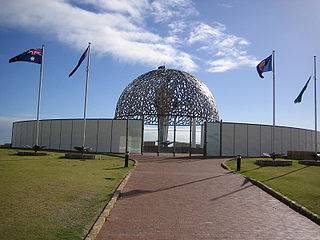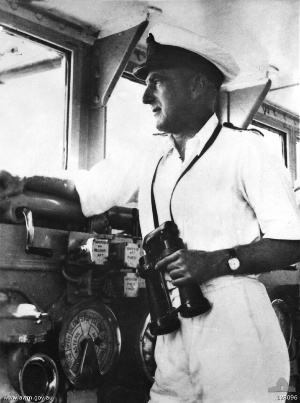Related Research Articles

An armed merchantman is a merchant ship equipped with guns, usually for defensive purposes, either by design or after the fact. In the days of sail, piracy and privateers, many merchantmen would be routinely armed, especially those engaging in long distance and high value trade.

HMAS Sydney, named after the Australian city of Sydney, was one of three modified Leander-class light cruisers operated by the Royal Australian Navy (RAN). Ordered for the Royal Navy as HMS Phaeton, the cruiser was purchased by the Australian government and renamed prior to her 1934 launch.

The British Iron Age is a conventional name used in the archaeology of Great Britain, referring to the prehistoric and protohistoric phases of the Iron Age culture of the main island and the smaller islands, typically excluding prehistoric Ireland, which had an independent Iron Age culture of its own. The parallel phase of Irish archaeology is termed the Irish Iron Age. The Iron Age is not an archaeological horizon of common artefacts but is rather a locally-diverse cultural phase.
The year 2000 in archaeology included many events, some of which are listed below.
The year 1997 in archaeology involved some significant events.
The year 1933 in archaeology involved some significant events.
The year 1935 in archaeology involved some significant events.

On 19 November 1941, the Australian light cruiser HMAS Sydney and the German auxiliary cruiser Kormoran engaged each other in a battle off the coast of Western Australia. Sydney, with Captain Joseph Burnett commanding, and Kormoran, under Fregattenkapitän Theodor Detmers, encountered each other approximately 106 nautical miles off Dirk Hartog Island. The single-ship action lasted half an hour, and both ships were destroyed.
The decade of the 1790s in archaeology involved some significant events.
The year 2007 in archaeology

Numerous attempts were made to find the Australian cruiser HMAS Sydney and the German auxiliary cruiser Kormoran, which were both lost in a sea battle in 1941. Efforts immediately after the battle focused on finding Sydney when she failed to return to port. While searchers located over 300 survivors from Kormoran, none of the 645 aboard the Australian warship were found.

Joseph Burnett was a Royal Australian Navy (RAN) officer most widely known as the captain of the light cruiser HMAS Sydney in the battle between HMAS Sydney and HSK Kormoran on 19 November 1941. He fought in both the First World War and Second World War, serving in the RAN and the Royal Navy (RN), and went down with the Sydney off the coast of Western Australia.
David Louis Mearns, OAM, M.Sc., is an American-born United Kingdom based marine scientist and oceanographer, who specializes in deep water search and recovery operations, and the discovery of the location of historic shipwrecks.
The year 2010 in archaeology

The Bredon Hill Hoard is a hoard of 3,784 debased silver Roman coins discovered in June 2011 by two metal detectorists on Bredon Hill in Worcestershire, approximately 400 metres north of Kemerton Camp, an Iron Age hill fort. The coins were found in a clay pot that had been buried around the middle of the 4th century in a Roman villa, identified by the subsequent archaeological excavation. The coins include the reigns of sixteen different emperors during the mid to late 3rd century, and are the largest hoard of Roman coins to have been discovered in Worcestershire to date.
The year 2014 in archaeology involved some significant events.
This page lists major archaeological events of 2015.

Elizabeth Eames was a British archaeologist and scholar who specialised in the study of medieval tiles. Her expertise grew out of a job at the British Museum which involved cataloguing and conserving their collection of decorated English medieval floor tiles. She became an authority on this aspect of medieval archaeology and, as well as publishing books and articles, moved on to excavation of further tiles from pavements and kilns, and the study of medieval building techniques. She also taught in a variety of settings.
The Bom Jesus was a Portuguese nau and Indiaman that set sail from Lisbon, Portugal, on Friday, March 7, 1533. Its fate was unknown until 2008, when its remains were discovered during diamond mining operations on the coast of Namibia, near Oranjemund. Today, the Bom Jesus is the oldest known and most valuable shipwreck ever discovered off the Western coast of Sub-Saharan Africa.
References
- ↑ Stonehenge - The Healing Stones, Day 1: Ground-breaking stuff Archived April 6, 2008, at the Wayback Machine , by the BBC. Retrieved 14 February 2009.
- ↑ Hunter, Richard W.; Burrow, Ian C. (2010). "Steel away". In Belford, Paul; et al. (eds.). Footprints of Industry. Oxford, England: Archaeopress. pp. 69–88. ISBN 978-1-4073-0727-5.
- ↑ Fogarty, Philippa (30 December 2014). "The search for Australia's lost hospital ship". BBC News. Retrieved 27 November 2017.
- ↑ The 16th century Portuguese shipwreck of Oranjemund, Namibia (PDF).
- ↑ "Tory Lord defends the treasure hunt for HMS Victory". The Telegraph. Archived from the original on 18 February 2015. Retrieved 27 November 2017.
- ↑ "Divers find shipwreck in Lake Michigan off Sheboygan coast". St. Paul Pioneer Press . Saint Paul, Minnesota. 2008-05-19. Retrieved 2021-02-21.
- ↑ "German 'Venus' may be oldest yet". BBC News. 14 May 2009. Retrieved 27 November 2017.
- ↑ Salme shipfind.
- ↑ "WWII German bomber to be recovered from Goodwin Sands". BBC News. 3 September 2010. Archived from the original on 8 April 2011. Retrieved 2011-04-08.
- 1 2 National Heritage Memorial Fund (2012), Annual Report and Accounts for the year ended 31 March 2012, London: The Stationery Office, ISBN 9780102978193
- ↑ "Ancient axe find suggests Copper Age began earlier than believed". Thaindian.com. Archived from the original on 2019-02-06. Retrieved 2009-10-18.
- ↑ "Stone Pages Archaeo News: Ancient metal workshop found in Serbia". Stonepages.com. Retrieved 2009-10-18.
- ↑ (in Dutch) Keltische schat ontdekt met detector, by the Algemeen Dagblad. Retrieved 9 January 2009. [ dead link ]
- ↑ "The Ship London on her first voiadge". www.royalcollection.org.uk. Retrieved 27 November 2017.
- ↑ "The South Warwickshire Roman Hoard". Our Warwickshire. Retrieved 2019-02-18.
- ↑ Cunliffe, Barry W (2008). Europe between the oceans: themes and variations, 9000 BC - AD 1000. Yale University Press. OCLC 173182722.
- ↑ "Classical greece and birth western art | Classical studies (general)". Cambridge University Press.
- ↑ "Ethiopia unveils ancient Obelisk". BBC News. 4 September 2008. Retrieved 16 May 2017.
- ↑ World Archaeological Congress honors Larry Zimmerman [ permanent dead link ], by Indian Country Today. Retrieved 14 February 2009.
- ↑ Wilson, David M. (29 September 2008). "Obituary: Elizabeth Eames". The Guardian. Retrieved 4 June 2017.